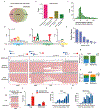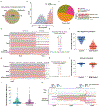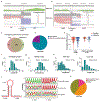Full-length RNA profiling reveals pervasive bidirectional transcription terminators in bacteria
- PMID: 31308523
- PMCID: PMC6814526
- DOI: 10.1038/s41564-019-0500-z
Full-length RNA profiling reveals pervasive bidirectional transcription terminators in bacteria
Abstract
The ability to determine full-length nucleotide composition of individual RNA molecules is essential for understanding the architecture and function of a transcriptome. However, experimental approaches capable of capturing the sequences of both 5' and 3' termini of the same transcript remain scarce. In the present study, simultaneous 5' and 3' end sequencing (SEnd-seq)-a high-throughput and unbiased method that simultaneously maps transcription start and termination sites with single-nucleotide resolution-is presented. Using this method, a comprehensive view of the Escherichia coli transcriptome was obtained, which displays an unexpected level of complexity. SEnd-seq notably expands the catalogue of transcription start sites and termination sites, defines unique transcription units and detects prevalent antisense RNA. Strikingly, the results of the present study unveil widespread overlapping bidirectional terminators located between opposing gene pairs. Furthermore, it has been shown that convergent transcription is a major contributor to highly efficient bidirectional termination both in vitro and in vivo. This finding highlights an underappreciated role of RNA polymerase conflicts in shaping transcript boundaries and suggests an evolutionary strategy for modulating transcriptional output by arranging gene orientation.
Conflict of interest statement
Competing interests
The Rockefeller University has filed a provisional patent application encompassing aspects of the SEnd-seq technology on which S.L. and X.J. are listed as inventors.
Figures






Similar articles
-
Unprecedented high-resolution view of bacterial operon architecture revealed by RNA sequencing.mBio. 2014 Jul 8;5(4):e01442-14. doi: 10.1128/mBio.01442-14. mBio. 2014. PMID: 25006232 Free PMC article.
-
Parameters affecting transcription termination by Escherichia coli RNA. II. Construction and analysis of hybrid terminators.J Mol Biol. 1992 Mar 5;224(1):53-63. doi: 10.1016/0022-2836(92)90575-5. J Mol Biol. 1992. PMID: 1372366
-
Sourcing Phage-Encoded Terminators Using ONT-cappable-seq for SynBio Applications in Pseudomonas.ACS Synth Biol. 2023 May 19;12(5):1415-1423. doi: 10.1021/acssynbio.3c00101. Epub 2023 Apr 24. ACS Synth Biol. 2023. PMID: 37092882 Free PMC article.
-
Deep sequencing approaches for the analysis of prokaryotic transcriptional boundaries and dynamics.Methods. 2017 May 1;120:76-84. doi: 10.1016/j.ymeth.2017.04.016. Epub 2017 Apr 21. Methods. 2017. PMID: 28434904 Review.
-
Advances in bacterial transcriptome understanding: From overlapping transcription to the excludon concept.Mol Microbiol. 2020 Mar;113(3):593-602. doi: 10.1111/mmi.14456. Mol Microbiol. 2020. PMID: 32185833 Free PMC article. Review.
Cited by
-
Massively parallel characterization of engineered transcript isoforms using direct RNA sequencing.Nat Commun. 2022 Jan 21;13(1):434. doi: 10.1038/s41467-022-28074-5. Nat Commun. 2022. PMID: 35064117 Free PMC article.
-
Transformers and large language models in healthcare: A review.Artif Intell Med. 2024 Aug;154:102900. doi: 10.1016/j.artmed.2024.102900. Epub 2024 Jun 5. Artif Intell Med. 2024. PMID: 38878555 Free PMC article. Review.
-
High-throughput method characterizes hundreds of previously unknown antibiotic resistance mutations.Nat Commun. 2025 Jan 17;16(1):780. doi: 10.1038/s41467-025-56050-2. Nat Commun. 2025. PMID: 39824824 Free PMC article.
-
An RNA-centric global view of Clostridioides difficile reveals broad activity of Hfq in a clinically important gram-positive bacterium.Proc Natl Acad Sci U S A. 2021 Jun 22;118(25):e2103579118. doi: 10.1073/pnas.2103579118. Proc Natl Acad Sci U S A. 2021. PMID: 34131082 Free PMC article.
-
Head-on and co-directional RNA polymerase collisions orchestrate bidirectional transcription termination.Mol Cell. 2023 Apr 6;83(7):1153-1164.e4. doi: 10.1016/j.molcel.2023.02.017. Epub 2023 Mar 13. Mol Cell. 2023. PMID: 36917983 Free PMC article.
References
-
- Sharma CM et al. The primary transcriptome of the major human pathogen Helicobacter pylori. Nature 464, 250–5 (2010). - PubMed
Publication types
MeSH terms
Substances
Grants and funding
LinkOut - more resources
Full Text Sources
Molecular Biology Databases

